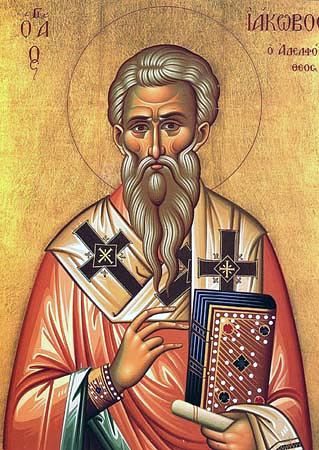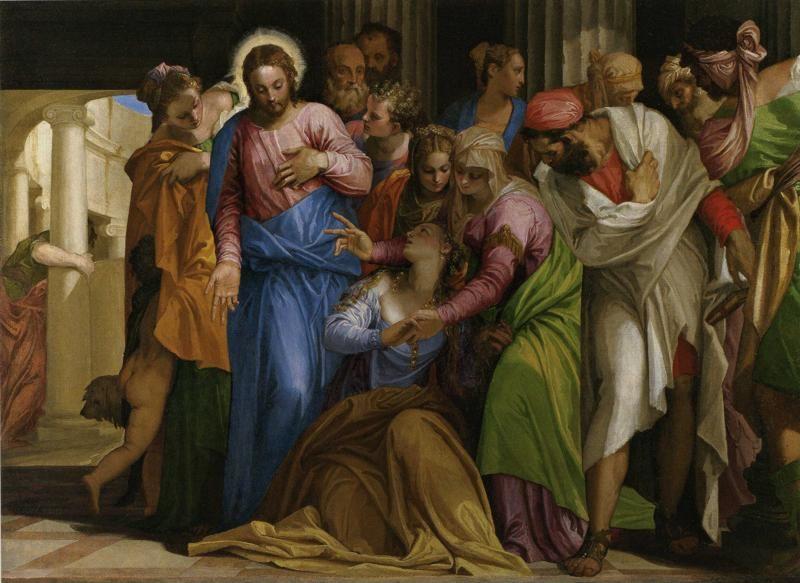
The “Laughing Jesus…”
* * * *
 First a note: I originally posted this on January 23, 2015. But yesterday, reading over some old posts, I noticed the bottom picture in this one was missing. Or more precisely there was a box with some information written inside, probably “URL” information or the like. So I decided to re-post this one, and may do the same with others, like Jonah and the bra-burners, first posted on January 19, 2015. (And leading with the picture at left.)
First a note: I originally posted this on January 23, 2015. But yesterday, reading over some old posts, I noticed the bottom picture in this one was missing. Or more precisely there was a box with some information written inside, probably “URL” information or the like. So I decided to re-post this one, and may do the same with others, like Jonah and the bra-burners, first posted on January 19, 2015. (And leading with the picture at left.)
So here’s a “new improved version” of Jesus “cracking wise.”
* * * *
The Gospel reading for January 18[, 2015] was John 1:43-51. It told of Jesus meeting Philip and Nathanael. An earlier post (Bible readings for January 18) told of a commentator saying Nathanael was a bit of a “wiseacre.” Commentator also suggested that Jesus greeted Nathanael with a sarcastic joke, “Behold, an Israelite indeed, in whom [there] is no guile!” This was after Nathanael was reluctant to “come and see” the man Philip thought was the Messiah.
The idea of this “sarcastic joke to Nathanael” came from a Sacred Story article. The article said the Israel Jesus referred to “was the new name of Jacob, who was well-known as a deceitful trickster who fooled both his father and brother.’” I also noted some contrary, “more traditional” interpretations, such as John 1:47 When Jesus saw Nathanael:
[Jesus] is described as knowing what was in man… He makes use of his Divine prerogative [and] penetrated the surface to [Nathanael’s] inner motive and heart. Behold, an Israelite indeed; one who fulfils the true idea of Israel, a prince with God, a conqueror of God by prayer, and conqueror of man by submission, penitence, and restitution… In whom is no guile; i.e. no self-deception, and no disposition to deceive others.
So the Pulpit Commentary on John 1:47 had Jesus saying Nathanael was not a deceitful trickster. Rather Jesus was saying Nathanael was a true “prince with God,” a penitent man with “no disposition to deceive others.” And Gill’s Exposition of John 1:47 interpreted the phrase “behold an Israelite indeed” as meaning “a true son of Jacob’s; an honest, plain hearted man.”
So which was it? Was Jesus saying Nathanael was an “honest, plain-hearted man,” without guile or deceit, “just like Jacob?” Or was Jesus being sarcastic, “cracking wise?”
 We can start with the fact that the name “Israel” referred to a man who literally wrestled with God. (See On arguing with God, with the image at right.) That’s how Jacob got his name changed to Israel.
We can start with the fact that the name “Israel” referred to a man who literally wrestled with God. (See On arguing with God, with the image at right.) That’s how Jacob got his name changed to Israel.
(That post also said maybe we too should wrestle with God: “that’s how we get spiritually stronger, by ‘resistance training,’” not “passively accepting” everything in the Bible.)
But we also know that Jacob was shrewd, starting from the moment of his birth. Jacob and twin brother Esau literally “wrestled in the womb.” And while Esau was born a few seconds before his brother, “his heel was grasped by the hand of Jacob.” The name Jacob – Ya`aqovin Hebrew – literally translates to “heel-catcher,” “leg-puller,” or “supplanter.” See Jacob – Wikipedia, the free encyclopedia, and also Genesis 25:19-28. (Verse 28 also notes that while the father Isaac loved Esau – his first-born son – Rebekah the mother loved Jacob more.)
Isaac Asimov added that since Esau was born first, he was entitled to inherit the first-born’s “main portion of his father’s property.” (Such a blessing had “great legalistic value in the society of that time.”) But Jacob outmaneuvered his older brother, getting his birthright in exchange for some “pottage,” when Esau was starving. See Genesis 25:27-34, “Thus Esau despised his birthright.” So this was when Jacob “fooled his brother,” as noted in Sacred Story.
Then – as Asimov noted – came a “second successful deceit on the part of Jacob.”
Years later, as Isaac lay “blind and awaiting death,” he wanted to give Esau his final blessing. (That also had “great legalistic value”). But Jacob fooled his father by dressing up in Esau’s clothes and putting goatskins on his arms “to imitate Esau’s hairiness.” (This all happened as Esau was out hunting, at his father’s request, to prepare one last time the “savory food” his father Isaac loved so much.) The story in Genesis 27:1-45 goes on to tell of Esau hating and planning to kill Jacob, because of his trickery. (The blind and “tricked” Isaac gave Jacob his final blessing, not Esau.) Genesis 27 also told of his mother’s scheme to save him. So here we’ve seen the story of Jacob fooling “both his father and brother.”
But wait, there’s more!
Rebekah sent Jacob to stay with her brother Laban. Laban ended up as Jacob’s father-in-law, after first tricking him – Jacob – to marry Leah, his first-born daughter. (See, Jacob really loved and “bargained for” Rachel, but Leah had to get married first, by the law of the time, so he ended up marrying both of them.) Which led to yet another bit of “guile” on the part of Jacob.
He wanted to return home – with wives Rachel and Leah – but he also wanted compensation:
Laban was reluctant to release him, as God had blessed his flock on account of Jacob. Laban asked what he could pay Jacob. Jacob proposed that all the spotted, speckled, and brown goats and sheep of Laban’s flock, at any given moment, would be his wages. Jacob placed peeled rods of poplar, hazel, and chestnut within the flocks’ watering holes or troughs…
 See Jacob. (With the image of him and his mother Rachel, at left.) See also Genesis 30 … Bible Gateway, verses 25-42, titled “Jacob Prospers at Laban’s Expense.” Briefly, Jacob agreed to be paid by taking only the “speckled and spotted sheep and every black lamb, and the spotted and speckled among the goats.” But then he made the peeled rods of poplar, hazel, and chestnut noted above, and put them in front of watering holes. According to the Bible, that’s the trickery that made Jacob rich:
See Jacob. (With the image of him and his mother Rachel, at left.) See also Genesis 30 … Bible Gateway, verses 25-42, titled “Jacob Prospers at Laban’s Expense.” Briefly, Jacob agreed to be paid by taking only the “speckled and spotted sheep and every black lamb, and the spotted and speckled among the goats.” But then he made the peeled rods of poplar, hazel, and chestnut noted above, and put them in front of watering holes. According to the Bible, that’s the trickery that made Jacob rich:
[S]ince they bred when they came to drink, the flocks bred in front of the rods and so the flocks brought forth striped, speckled, and spotted… Whenever the stronger of the flock were breeding Jacob laid the rods in the runnels before the eyes of the flock, that they might breed among the rods, but for the feebler of the flock he did not lay them there; so the feebler were Laban’s, and the stronger Jacob’s. Thus the man [Jacob] grew exceedingly rich…
So Jacob grew exceedingly rich at the expense of his father-in-law. He bargained for “only” the speckled and spotted sheep, then took steps to make sure that most of the sheep and the strongest of the sheep turned out to be “speckled and spotted.”
 In the fullness of time, Jacob went on to “wrestle with God” and become the patriarch Israel,as told in Genesis 32:22-32. He fathered 12 sons, who became the 12 tribes of Israel: “The children named in Genesis were Reuben (shown at right), Simeon, Levi, Judah, Dan, Naphtali, Gad, Asher, Issachar, Zebulun, daughter Dinah, Joseph, and Benjamin.” (See Jacob, which also indicated daughter Dinah didn’t count as a “tribe.”)
In the fullness of time, Jacob went on to “wrestle with God” and become the patriarch Israel,as told in Genesis 32:22-32. He fathered 12 sons, who became the 12 tribes of Israel: “The children named in Genesis were Reuben (shown at right), Simeon, Levi, Judah, Dan, Naphtali, Gad, Asher, Issachar, Zebulun, daughter Dinah, Joseph, and Benjamin.” (See Jacob, which also indicated daughter Dinah didn’t count as a “tribe.”)
Which gets us back to the question: When Jesus greeted Nathanael in John 1:47 – Behold an Israelite indeed, in whom [there] is no guile!” – what was He really saying? Was He saying Nathanael was a “prince with God,” a penitent man with “no disposition to deceive?” Or was He “cracking wise?” (Or maybe He was quoting Psalm 32:2, “Happy are they to whom the Lord imputes no guilt, and in whose spirit there is no guile!” Which still doesn’t solve the question.)
John 1:43-45 described Philip meeting Jesus, then going to find Nathanael and tell him the news; “Jesus of Nazareth was the one foretold in the scriptures as the savior of his people.” As the Sacred Story article went on to say, “Nathanael listened, and made a wise-crack – ‘Can anything good come out of Nazareth?‘” (See John 1:46)
So the question is: Did Jesus respond to Nathanael’s sarcastic comment – under the fig tree – with a sarcastic comment of His own? Did Jesus laugh, make jokes, be sarcastic?
That’s ultimately for you to decide, but I’ve said all along that God has a sense of humor.
Aside from making Mick Jagger a grandfather, there’s also Psalm 2:4, “He who sits in the heavens laughs, the Lord scoffs at them.” Psalm 37:13 says, “The LORD laughs at the wicked, because He sees that their day will come.” (That’s Psalm 37:14 in the BCP Revised Standard version.) Then there’s Psalm 59:8, “But you laugh at them, LORD; you scoff at all those nations.” And finally see Psalm 104:26, “there is that Leviathan, which you [God] have made for the sport of it.” (Psalm 104:27 in the BCP RSV.)
In turn I’ve done many posts on the subject. Just type in “God sense humor” in the search-box above right. Those posts include On Robin Williams’ “Top Ten,” in memory of man who “had a gift for turning tragedy into something we could laugh at – and with.”
But don’t just take my word for it. There’s also the site Who was Canadian behind iconic image of “Laughing Jesus?” That’s where the image above came from, but there’s some debate about who actually created the original. Be that as it may, it’s popular: “One of the most popular images of Jesus today is a painting of him laughing.”
Unfortunately, time and space – not to mention the reader’s “attention span of a gerbil” – are running out. That means it’s time to wrap this up.
We can close by noting there’s also some question about who this sarcastic Nathanael really was. The consensus is that he was actually Bartholomew the Apostle, “one of the Twelve Apostles of Jesus, and is usually identified with Nathanael (alternatively spelled Nathaniel).”
See also Nathanael – Believed To Be The Apostle Bartholomew: “Church tradition says Nathanael carried a translation of Matthew’s Gospel to northern India. Legend claims he was crucified upside down in Albania.”
Which means there’s enough tragedy to around, as if we didn’t know that already. (Crucified upside down in Albania, indeed!) In turn it would be nice to think that Jesus, like Robin Williams, “had a gift for turning tragedy into something we could laugh at – and with.”
* * * *

Leviathan, which God made “for the sport of it…”
* * * *
The upper image is courtesy of Laughing Jesus – Image Results.
The full citation for the “Sacred Story” article is sacredstory.org/2012 … nathanael-and-the-fig-tree. From the Sacred Story home page: “Do you wonder about your life as a spiritual journey? Do you have questions about the Bible? Are you interested in conversations about God? Then this blog is written for you – not as an easy source of authoritarian answers, but as a shared exploration of the questions.” Ditto!!!
The lower image is courtesy of Leviathan – Wikipedia, with the caption: “‘Destruction of Leviathan,’ 1865 engraving by Gustave Doré.’”
See also Bartholomew the Apostle – Wikipedia, “He is described as initially being skeptical about the Messiah coming from Nazareth, saying: ‘Can anything good come out of Nazareth?’”
The post Bible readings for January 18 included notes on the term wiseacre, variously defined as: 1) a person who possesses or affects to possess great wisdom; 2) a wise guy; or 3) “Old person speak for smartass.” Dictionary.com added the term is “often used facetiously or contemptuously.”

 Most people think
Most people think  Another thing they did was build bonfires, literally
Another thing they did was build bonfires, literally  In turn, both the jack-o’-lantern and
In turn, both the jack-o’-lantern and 

 According to
According to  Be that as it may, here’s what the Wikipedia article said about this particular “10/23” James – whose “icon” is shown at right:
Be that as it may, here’s what the Wikipedia article said about this particular “10/23” James – whose “icon” is shown at right: I discussed this parable in
I discussed this parable in 

 Thursday, October 18, is the
Thursday, October 18, is the  That’s when it hit me. The priest’s theory wasn’t all that crazy. There was
That’s when it hit me. The priest’s theory wasn’t all that crazy. There was 
 I’ve been listening to the book-on-CD version of
I’ve been listening to the book-on-CD version of  And incidentally,
And incidentally,  See also
See also  So I was wrong in saying there are “some few ‘soldiers of Christ’ who enjoy having no additional responsibility.” As in any army, “privates” make up the bulk of personnel, not “some few.” That is, I’ve reconsidered
So I was wrong in saying there are “some few ‘soldiers of Christ’ who enjoy having no additional responsibility.” As in any army, “privates” make up the bulk of personnel, not “some few.” That is, I’ve reconsidered 

 As far as
As far as  See also
See also 

 I just got back from three weeks canoeing the
I just got back from three weeks canoeing the 


 (See also
(See also  Which didn’t suit them at all. See
Which didn’t suit them at all. See  (From the
(From the 

 Last Sunday – July 22 – was the
Last Sunday – July 22 – was the  Which brings up the matter of “so-called conservative Christians,” and the
Which brings up the matter of “so-called conservative Christians,” and the 

 For an explanation of the symbols in the cartoon, see the notes. But the point is that even a smart guy like Thomas Jefferson could have some really stupid ideas.
For an explanation of the symbols in the cartoon, see the notes. But the point is that even a smart guy like Thomas Jefferson could have some really stupid ideas. But getting back to Thomas Jefferson and his role as
But getting back to Thomas Jefferson and his role as 